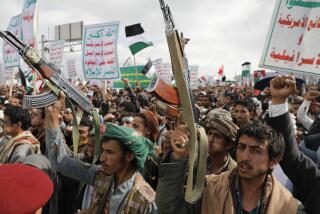Terror Use of Afghan Rebel Missiles Feared
- Share via
WASHINGTON — The U.S. weapons that many believe turned the tide against Soviet forces in Afghanistan--Stinger anti-aircraft missiles--are now causing “serious concern” that they will fall into the hands of Iranian or other terrorists when the Afghan war ends, senior U.S. officials said last week.
Many hundreds, perhaps more than 1,000 Stingers have been shipped to the region since mid-1986 when the decision was made, under considerable congressional pressure, to provide the weapons to Afghan moujahedeen, the Muslim guerrillas fighting the Kabul government and Soviet occupation troops. Between 100 and 200 Stingers are believed to be in guerrilla hands inside Afghanistan at present, and one U.S. official has suggested that there is the potential for 20% of them to be lost.
Even a few Stingers in terrorist hands could pose great danger to civilian airliners. Portable, shoulder-launched Stingers that home in on the exhaust heat of jet aircraft have been called “the perfect terrorist weapon.”
Iranians Got Missiles
Last year, one dozen to two dozen Stingers that had been provided to one Afghan rebel band were sold to Iran or hijacked by that country. In October, components of Stingers were found on an Iranian gunboat in the Persian Gulf, which was captured after it fired on a U.S. helicopter escorting U.S.-registered Kuwaiti tankers.
Authoritative Administration officials Saturday denied published reports that Stinger shipments to the Afghan guerrillas have been cut off in anticipation of a peace settlement being negotiated.
Other sources said the entire 1988 Stinger consignment has already been delivered. The rest of the military aid consignment, estimated to be worth $300 million, has also been filled. No cutoff in aid is contemplated until a settlement is achieved, sources emphasized.
“The Stingers not now in moujahedeen hands (those in the weapons pipeline or in storage in Pakistan) we can get back, but the rest we have no control over” said Richard L. Armitage, assistant defense secretary for international security affairs. “It’s been a concern steadily,” he added.
In fact, according to a senior U.S. official, the danger that is now causing anxiety here was a major reason why the CIA initially objected to providing the weapons to the rebels. The Pentagon also shared this fear and suggested that the missiles might be too complicated for them to handle.
‘Fantastic Success’
However, the rebels proved exceedingly adept in using the weapons. “They’ve had a fantastic success rate, averaging maybe one aircraft a day for the past year,” one senior official said. “Without the Stinger, I doubt the Soviets would be leaving. I think this weapon has turned the tide.”
Use of the ground-to-air missile is easier in Afghanistan than other areas for several reasons, he explained. There are no friendly aircraft in the skies, so identification of friend or foe is no problem. And the mountainous terrain favors those with Stingers, because the rebels can get above the aircraft attacking in the valleys and because there are limited landing places even for helicopters.
“It’s good ambush territory,” the official added, “but these moujahedeen actually go after the aircraft. They go to where the aircraft are based and taking off rather than wait for them to come to attack,” he said admiringly.
U.S. officials hope that with the end to the Afghan conflict, the guerrillas will find little use for Stingers and may return them, or even trade them for more useful weapons such as light machine guns, in a “buy-back” scheme.
The moujahedeen are now divided among at least seven major groups. “Once the various factions fall to squabbling among themselves--or once there’s a coalition government, if that happens--machine guns are going to be much more important determinants of political power than Stingers,” one source said.
But Armitage said the Afghan guerrillas’ affection for the Stingers means they will keep the weapons at least “in the near term. In the long term, we don’t know,” he said.
Numbers Checked
Efforts have been made, particularly since Stingers got into Iranian hands, to limit the number of missiles going to the moujahedeen by requiring an accounting of sorts. “We don’t issue a second missile if we don’t see the first one expended,” an official said. He refused to elaborate.
Moreover, there are various models of the Stinger. The basic “plain vanilla” model, one source said, needs two batteries to operate. Each battery has a one-year life expectancy, and the batteries are not readily available in the region. Only the Saudis and the Israelis could provide them, he said.
But terrorists have shown themselves excellent improvisers in such circumstances in the past, and U.S. officials knowledgeable about the Stingers fear that the weapons that won the war against the Soviet invaders will “turn around and bite” the United States and the West in the future.
Times staff writer Melissa Healy contributed to this story.
More to Read
Sign up for Essential California
The most important California stories and recommendations in your inbox every morning.
You may occasionally receive promotional content from the Los Angeles Times.













